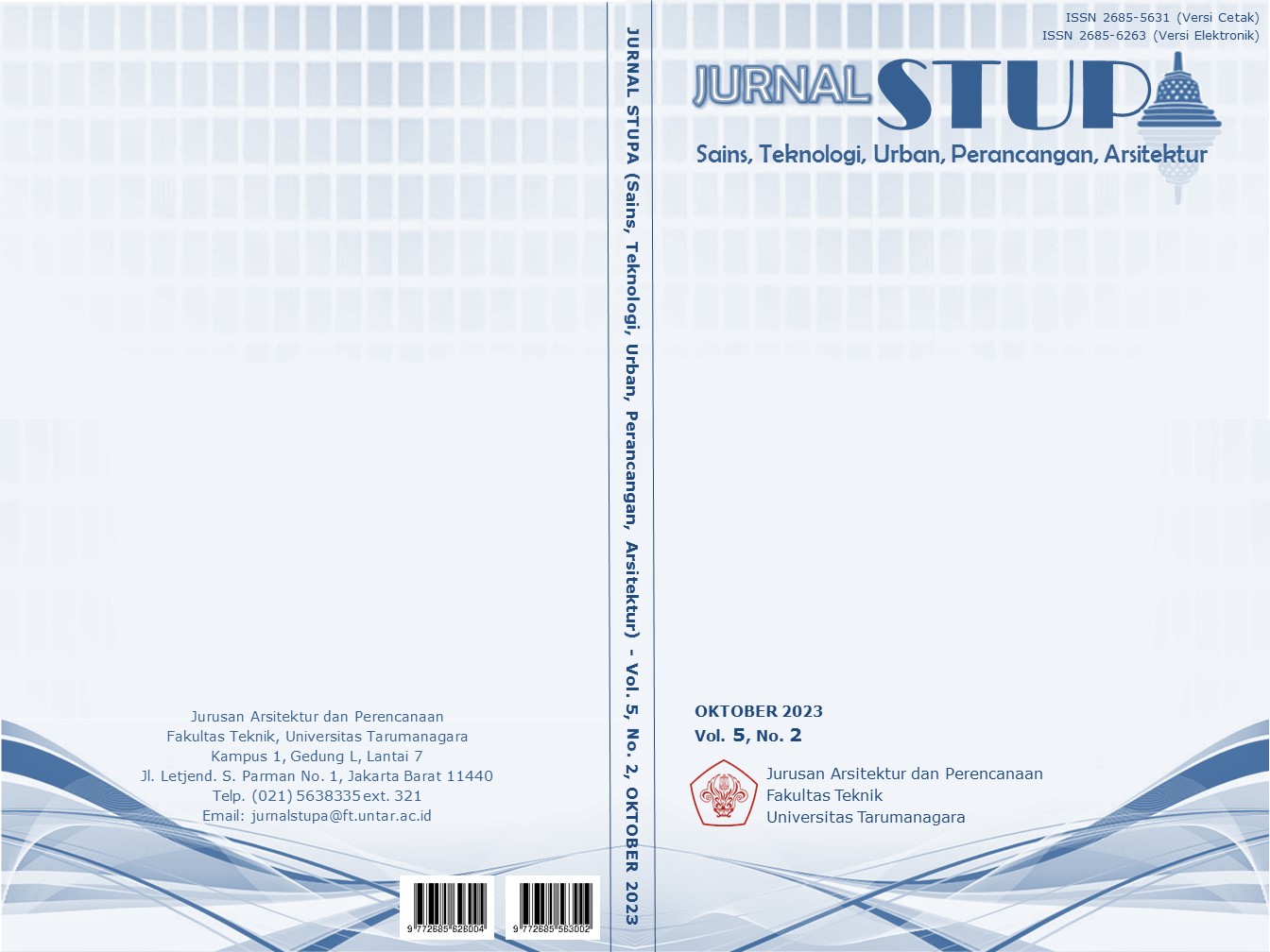PASAR ASEMKA JALAN LAYANG: KEKACAUAN DAN DISRUPSI YANG MENGHIDUPKAN KARAKTER RUANG PASAR ANALOG DI ERA DIGITAL
Main Article Content
Abstract
Around 6.7 million or 57% of market traders who were still operating reported a decrease in income of around 70%-90% compared to the normal situation because people's behavior began to shift from buying offline to online, causing economic disruption. Limited land in areas busy with economic traffic makes traders must find ways to survive. Asemka Market is one of the locations experiencing a similar situation. Pasar Asemka is famous for its wholesale center for goods, now accessories have decreased, especially with the inconvenience and mismatch between sellers and buyers in carrying out buying and selling activities better and more effectively. This research breaks through how sellers in the analog market can survive and buyers can feel more comfortable in shopping at the analog market with the character of a market space that is generally considered messy and messy. The aim of the research is to trace messiness and disruption as spatial characters of Asemka Market using observational methods along with documentation to find out the trading system, activities, and behavior of sellers in Asemka Market, activities and behavior of buyers who come, what goods are sold, and how circulation is carried out. what happened in Asemka Market and its surroundings. So that the characteristics and categories of sellers and buyers there can be applied to designs such as the flexibility of materials that help traders to create merchandise and become prototypes that can be used for empty areas that occur in big cities can be effective. As well as the comfort of circulation and the accessibility of migrants and buyers in the market and its surroundings, more attention is paid so as not to offend passing vehicles. Additional functions are also implemented so that the market can have life in some of its parts and provide other experiences for newcomers who visit.
Keywords: Disruption; Messiness; Market; Redefine; Redesign
Abstrak
Sekitar 6,7 juta atau 57% pedagang pasar yang masih beroperasi melaporkan penurunan pendapatan sekitar 70%-90% dibandingkan dengan situasi normal karena perilaku masyarakat yang mulai bergeser dari kebiasaan membeli secara offline menjadi cenderung online menyebabkan disrupsi ekonomi. Keterbatasan lahan di area ramai lalu lintas ekonomi membuat para pedagang harus mencari cara untuk tetap bertahan hidup Pasar Asemka menjadi salah satu lokasi yang mengalami hal yang serupa. Pasar Asemka terkenal akan pusat grosir barang aksesoris kini mengalami penurunan terutama dengan ketidaknyamanan dan ketidaksesuaian ruang penjual dan pembeli dalam melakukan aktivitas jual beli dengan lebih baik dan efektif. Pada penelitian ini mempertanyakan bagaimanakah cara agar penjual di pasar analog tetap dapat bertahan dan pembeli dapat merasa lebih nyaman dalam berbelanja ke pasar analog dengan karakter ruang pasar yang umumnya dianggap kacau dan berantakan. Tujuan penelitian adalah untuk menelusuri messiness dan disrupsi sebagai karakter ruang dari Pasar Asemka dengan menggunakan metode pengamatan beserta dokumentasi untuk mengetahui sistem berdagang, aktivitas, dan perilaku penjual di Pasar Asemka, aktivitas dan perilaku pembeli yang datang, barang apa saja yang dijual, dan bagaimana sirkulasi yang terjadi di Pasar Asemka dan sekitar. Sehingga ciri-ciri dan kategori penjual dan pembeli disana dapat diterapkan pada desain seperti fleksibilitas bahan yang membantu para pedagang untuk menkreasikan barang dagang dan menjadi prototipe yang bisa digunakan bagi area kosong yang terjadi di kota-kota besar dapat efektif. Serta kenyamanan sirkulasi dan pencapaian pendatang dan pembeli didalam pasar dan disekitar lebih diperhatikan agar tidak menyinggung kendaraan yang lewat. Penambahan fungsi-fungsi juga diterapkan agar pasar dapat memiliki kehidupan dibeberapa potongannya dan memberikan pengalaman lain bagi para pendatang yang berkunjung.
Article Details

This work is licensed under a Creative Commons Attribution-NonCommercial-ShareAlike 4.0 International License.
This work is licensed under a Jurnal Sains, Teknologi, Urban, Perancangan, Arsitektur/ STUPA Creative Commons Attribution-NonCommercial-ShareAlike 4.0 International LicenseReferences
Chalana, M. &. (2016). Messy Urbanism: Understanding the “Other" Cities of Asia. Hong Kong: Hong Kong University Press.
Chan, N. W. (2012). Street markets in Hong Kong: a case of traditional sustainability. Journal of Place Management and Development 5(1), 25-41.
Chidambaram, L. &. (2012). Delving into the equifinality thesis: The role of national culture in understanding determinants of information technology adoption. MIS Quarterly, 36(1), 315-318.
Christensen, C. M., McDonald, R., Altman, E. J., & Palmer, J. E. (2018). Disruptive innovation: An intellectual history and directions for future research. Journal of management studies, 55(7), 1043-1078.
Hoffman, M. L. (2000). Empathy and Moral Development : Implications for Caring and Justice. Cambridge, UK: New York : Cambridge University Press.
Hou, M. C. (2016). Messy Urbanism; Understanding the "Other" Cities of Asia. Hong Kong: Hong Kong University Press.
Liana, P. A. (2021). Pandemi Bikin Pasar Sepi Pembeli, IKAPPI: 43 Persen Pedagang di Sejumlah Daerah Terpaksa Tutup. Retrieved July 20, 2021, from TribunJakarta: https://jakarta.tribunnews.com/2021/07/20/pandemi-bikin-pasar-sepi-pembeli-ikappi-43-persen-pedagang-di-sejumlah-daerah-terpaksa-tutup
Magdalena Lumbantoruan, B. Soewartoyo. (1992). Ensiklopedi Ekonomi, Bisnis, & Manajemen. Jakarta: Cipta Adi Pustaka.
Marthon, D. S. (2007). Ekonomi Islam : Di Tengah Krisis Ekonomi Global. Jakarta: Zikrul Hakim.
Mediastika, C. E. (2016). Understanding Empathic Architecture. Journal of Architecture and Urbanism , 1-2.
Mohd Noor, N. G. (2018). The Impact of Traditional Market on Local Economic Development. Journal of Global Business and Social Entrepreneurship (GBSE), 1(2), 66-72.
Nabela, D. (2017). STUDI EKSPLORASI FAKTOR-FAKTOR YANG MEMPENGARUHI TINGKAT 2. Jurnal Pendidikan dan Ekonomi.
Nambisan, S., & Baron, R. A. (2013). Entrepreneurship in innovation ecosystems: Entrepreneurs’ self–regulatory processes and their implications for new venture success. Entrepreneurship theory and practice, 37(5), 1071-1097.
Sundaram, D. S. (2019). Creating Social Value Through Disruptive Innovation in Markets. Journal of Business Research, 94, 349-359.
Swanson, K. K. (2017). Ethical Shopping and the Good Market: A Systematic Review and Research Agenda. Journal of Business Ethics, 146(2), 361-377.
Toni, A. (2013). EKSISTENSI PASAR TRADISONAL DALAM MENGHADAPI PASAR MODERN DI ERA MODERNISASI. El-Wasathiya: Jurnal Studi Agama, 1(2), 161.
Trancik, R. (1986). Finding Lost Space; Theories of Urban Design. New York: John Wiley &Sons, Inc.
Vignemont, F. d. (2006). When do we Empathize? In Empathy and Fairness. Bron: Novartis Foundation symposium.



